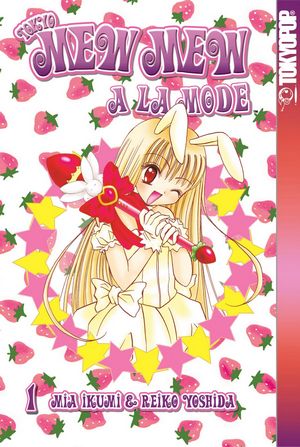Comics /
Manga
HEY, GIRLS! COMICS!: Tokyo Mew Mew a la Mode: Volume 1
By Leroy Douresseaux
November 8, 2005 - 00:06
TOKYO MEW MEW A LA MODE
MANGA-KA: Mia Ikumi
ISBN: 1595327894; soft cover
200 pp., B&W, $9.99 ($13.99 in Canada)
I didn’t have to read very much of
Tokyo Mew Mew a la Mode before I realized that this manga was not meant for me. It’s purely and simply a girl’s comic book or (as it originates in Japan) girls’ manga, and the fact that TOKYOPOP publishes it is one more indication of why that company has been such a rousing success in the American book market. By publishing graphic novels or (once again) manga collections aimed at young female readers – I’m guessing that the target audience for this is 9-12, with some female readers both a little younger and a little older (and in some cases, a lot older) – picking up the title.
Tokyo Mew Mew a la Mode is the sequel to
Tokyo Mew Mew, which was the story of five girls whose DNA merged with animals, as part of the secret “Mew Project;” in fact, the each girl is called a “Mew.” Their mission was to protect Earth from aliens who used animals to attack humans. In Mew Mew a la Mode, a sixth Mew named
Berry Shirayuki joins the team. She is also the first Mew with two sets of animal genes – that of a cat and a rabbit. A new group of villains, the
Saint Rose Crusaders are hunting the Mews, and their leader,
Yuzen Akizuki has a taste for wild game, specifically the rabbit. Volume 1 of a la Mode introduces us to Berry, and we see the difficult time she has accepting her powers and how she integrates into the team while trying to fight off the Crusaders.
The Mew Mews are ostensibly superheroes, but they are unlike, of course, the superheroes that make up the Marvel and DC comic book universes. For a long time, mainstream superhero comics have mostly been about superheroes battling super villains. In the Tokyo Mew Mew a la Mode, Volume 1 (of 3), Berry deals with her confused feelings about her long time friend, Masaya, who might end up being her boyfriend. She worries about fitting in with the rich girls at her new school (she studied hard to get into the school because the school uniform is cute), and about just fitting in at a school where the other students’ families are much better off financially than her family. She’s shy, and her attraction to another young man brings her to a cafe where her Mew Mew powers awaken. Then, she has to fit in with the other girls in Tokyo Mew Mew, including Ichigo, the original leader of Mew Mew who was in England with her boyfriend, but has returned just in time for Berry’s emergence.
The villains are certainly intriguing; there is just something about them that piqued my interest. However, manga-ka,
Mia Ikumi keeps them hidden in the background and in the shadows of the stories that make up this first volume. (It is important to remember that in Japan, manga is generally serialized in monthly manga magazines before they collected in book form.) Thus, the antagonists are vague, more like stylish ciphers than actually characters.
Ikumi’s art leans to the big-eyed, ultra pretty girls and boys common in shojo. But even to me, a long time fan of the art styles used in hardcore, traditional, guy superhero fight comics, Ikumi’s art here is eye pleasing. She draws very little actually hand-to-hand combat. Physical conflict ends up being buried behind prettily drawn girls waving wands and staffs covered in ribbons and Valentine’s Day knick-knacks.
Something like Tokyo Mew Mew would never have survived in the Direct Market, the distribution system through which just about the bulk of American mainstream comics are sold. Back in the 1980’s, Marvel tried to publish comics for little kids (the ill-fated “Star” line) and DC, through its Homage imprint, published a girl comic entitled,
Yeah, created by Peter Bagge and Gilbert Hernandez in the late 1990’s that died. The Tokyo Mew Mew line is a cross between a Star comic book and Yeah, and not enough of the audience for girls’ comics like those goes to DM comic book stores.
However, there
is a market where publishers and sellers go out of their way to sell to
anyone who can read, not just superhero readers, and that is the bookstore market. TOKYOPOP is savvy, and they realize that the comics medium or comic book format is popular with a large group of buyers who don’t actually buy comics (for various reasons, one of them being that there is little or nothing for them in DM comic shops). TOKYOPOP’s English language translation of Tokyo Mew Mew a la Mode is a result of that savvy thinking in which TOKYOPOP, as a publisher, gives book sellers something that they can sell to girls who would buy comics
if there were something they wanted to buy. After all, Mew Mew was a hit with girls in Japan. Lo and behold, American girls also like it. Turns out female readers like comics, too; there just wasn’t anything they wanted to buy… until now.
When the opportunity arises, take a look at Tokyo Mew Mew, and see that there is hope in making comics more than just a cult collectors market.
Mr. Charlie #70 reminds you that both Tokyo Mew Mew (seven volumes) and Tokyo Mew Mew a la Mode (two volumes published so far) are available in book chains like Barnes & Nobles and Books-a-Million, in some comic book stores, online (Amazon.com), or through the publisher.
Stop by my movie review site,
NEGROMANCER.
Last Updated: January 17, 2025 - 08:20
